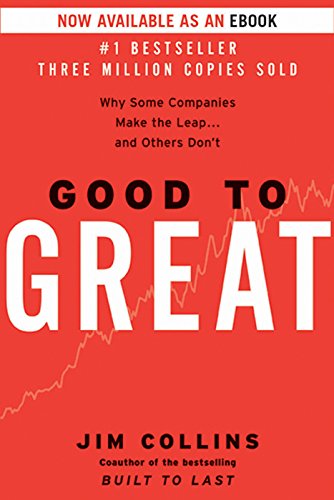

This article is an excerpt from the Shortform summary of "Good to Great" by Jim Collins. Shortform has the world's best summaries of books you should be reading.
Like this article? Sign up for a free trial here .
Great companies hire the right people before embarking on any specific program. Why?
Learn why hiring the right people first is more important than having the right idea, and learn how to identify the people who are “right.”
The Importance of Hiring the Right People
Top-Line Takeaways
- Good-to-great companies recruit and hire the right people before embarking on any transformative changes.
- In the good-to-great companies, the management team was cast as a group of equals pushing toward a common goal. Comparison companies, meanwhile, typically followed the “genius with a thousand helpers” model—when a visionary leader surrounds him- or herself with people who can help realize that specific vision.
- Good-to-great executives will perform regardless of the specifics of the compensation system, as long as compensation is reasonable.
- Leaders of the good-to-great companies were disciplined in hiring and firing decisions, but they weren’t ruthless—they made people changes according to a rigorous standard and relied far less than their comparison-company peers on layoffs and restructurings.
- Good-to-great teams boast a comradeship that lasts well beyond their tenure with the company.
Passengers First, Destination Later
Contrary to their expectations, Collins et al. discovered that good-to-great leaders hired the right people before implementing any revolutionary reforms or setting off in a new direction.
The good-to-great executives concentrated on hiring the right people first for three reasons:
- When good people come on board before a new direction is unveiled, they’re coming on board because of who else is on board. This means, if the company has to change direction down the road, these folks will stick with you—because it was never about the direction in the first place.
- With the right people, the need for motivation and management diminishes significantly—you’ve already determined your team is there for the right reasons and can handle whatever challenges arise.
- Great vision without great people is a nonstarter—even the most innovative executive needs a diversely talented team to help realize his or her goals.
Hiring the Right People: Wells Fargo
Wells Fargo’s rapid rise began in 1983, but the groundwork for its triumph was laid a decade earlier, when then-CEO Dick Cooley put together one of the most talented management teams in banking (the most talented, according to Warren Buffett).
Cooley predicted that banking would undergo massive changes in the coming decades, but he was also humble enough to know he couldn’t predict what those changes would be. So he instead decided to attract and retain as much talent as he could, even if positions had to be created for the new hires.
The strategy paid off when the major change—banking deregulation—came. While Wells Fargo’s sector as a whole trailed the general stock market by 59%, Wells Fargo boasted returns 3x the market.
Wells’s eye for talent was confirmed in the years after its triumph. Many of the executives that oversaw the bank’s navigation of banking deregulation went on to become CEOs of other major companies, including U.S. Bancorp, Household Finance, and Bank of America.
Hiring the Right People: Pitney Bowes
Dave Nassef, an executive at Pitney Bowes, spent time in the Marine Corps, and he and his managers look more for character and discipline than technical skills when they make hires.
The idea is that job-specific skills can be taught, whereas work ethic, moral rectitude, and dedication are much harder to instill in someone who lacks them.
When It Comes to Hiring the Right People, the Compensation System Doesn’t Matter
One might expect good-to-great companies to employ executive compensation schemes that favor stock options—how else are you going to incentivize executive performance and hire the right people?
But Collins found no correlation between compensation systems and performance: Some good-to-great CEOs were compensated with stock, others with cash. Collins also found a wide range among the good-to-great executives in terms of salary amounts and bonus incentives.
The only consistent finding Collins turned up was that good-to-great executives tended to be paid less than their comparison counterparts ten years after the transition point.
It all points back to hiring the right people first. As long as the compensation package makes sense, the right executives will work tirelessly to make a company great. Level 5 leaders are driven not by financial incentives but personal principle.
Although data was less readily available for compensation for nonexecutive employees, what Collins et al. did find conforms with their topline finding—that getting the right people on the bus first mitigates the need to incentivize performance.
Disciplined, Not Destructive
Hiring the right people sometimes means cutting workers, but indiscriminate layoffs can result in good people being jettisoned.
Good-to-great companies operate according to rigorous standards for performance. If a manager or employee isn’t meeting the standard, then that person either needs to shape up or be cut loose. Mass layoffs to preserve capital or restructure the business, however, are rarely found in good-to-great companies.
Despite good-to-great companies’ rigorous expectations, these companies relied far less on head-count layoffs than the comparison companies. Of the 11 good-to-great companies Collins studied, 6 initiated no layoffs at all from ten years before the transition point to 1998, and four others recorded only one or two. Among the comparison companies, layoffs were 5x more common.
Hiring the Right People: Wells Fargo
Wells Fargo acquired Crocker Bank in 1986 and, shortly thereafter, laid off 1,600 managers, including most of Crocker’s top executives, on one day.
At first glance, this seems like a classic case of one company buying another for scrap. But in reality, Wells Fargo was adhering to their exacting standard for their managers.
Crocker’s management was old school, enjoying a lavish executive dining room with expensive China and a gourmet chef. Wells Fargo’s management, on the contrary, conducted itself much more humbly, eating food prepared by a service that typically fed college students, for example.
Wells’s management knew the majority of Crocker managers wouldn’t fall in line with Wells’s culture, and so they made the move. And not only: Wells retained some Crocker managers that met their standard and fired their own managers, thereby proving that ability and performance, rather than tenure or position, was king.
———End of Preview———

Like what you just read? Read the rest of the world's best summary of "Good to Great" at Shortform . Learn the book's critical concepts in 20 minutes or less .
Here's what you'll find in our full Good to Great summary :
- The 3 key attributes of Great companies
- Why it's better to focus on your one core strength than get spread thin
- How to build a virtuous cycle, or flywheel effect, in your business






